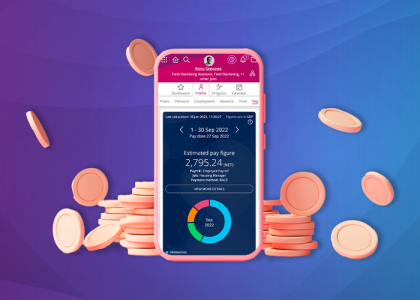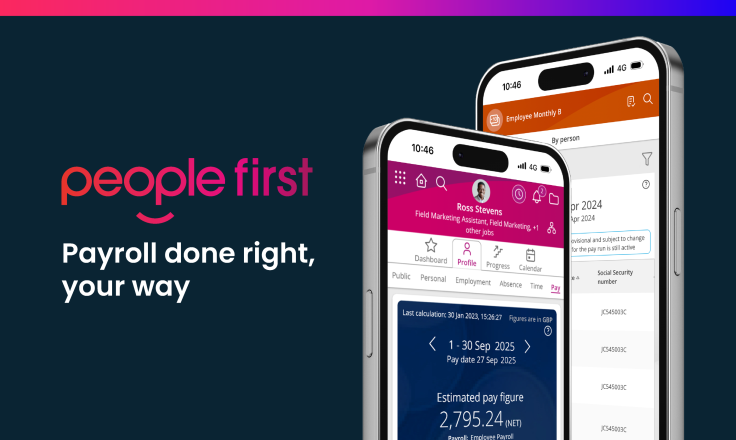What is a payslip?
Payslips are a record of how much an employee has been paid, and a way to track any deductions from their pay (such as through salary sacrifice schemes or tax).
In the past, payslips were always printed on paper, but more companies are switching to a paperless system for extra convenience and to help reduce their environmental impact. Either way, the information it must include is the same.
Who gets a payslip?
There are four distinct kinds of workers who are not automatically entitled to a payslip. Those are:
-
People who are not employees or workers (such as contractors or freelancers)
-
People in the police service
-
Merchant seaman
-
Crew members on share fishing vessels.
If they don’t fall under one of those categories, then you need to give them a payslip. Contractors and freelancers are responsible for paying their own taxes, so they’ll usually need you to sign invoices as an alternative.
What is the purpose of a payslip?
Payslips tell an employee how much they’ve earned, how much they’ve paid in tax and how much they’ve lost due to salary sacrifice. This gives them more certainty over their salary, helping them feel more financially secure and helping them to budget. That means a much-needed boost to financial well-being.
However, this isn’t the only thing payslips can be used for. They’re also a means to prove your identity (for example, if an employee wishes to access certain online tools like the Government Gateway).
There’s also the simple fact that things can sometimes go wrong. Payslips provide vital evidence if you or an employee come into conflict with HMRC's records or need to prove a loss of earnings.
If someone wants to apply for a mortgage or rent a property, they may need to use three months of payslips as evidence of earnings.
Are payslips required by law?
Yes. Payslip legislation is pretty straightforward in this regard.
We’ll go into the specific things to include on a payslip in more detail later in this guide, but the broad overview of what needs to be included is as follows:
- Earnings before and after deductions (these are referred to as gross amount and net amount respectively)
-
The amount of deductions that may change each time you’re paid (National Insurance and tax are the key examples)
-
The number of hours worked, if pay varies by time worked
You’ll also need to explain any deductions that are fixed in amount, although this can be written on the payslip or on a separate document.
When should your employees receive their payslips?
Payslips must be provided on or before payday.
If an employee doesn’t receive a payslip when expected, they can attempt to raise the issue informally. If that doesn’t help, they can then raise a grievance. Beyond that, they can bring you to an employment tribunal.
It’s in your best interest to make sure your employees get their payslips consistently on time before things reach their point. Nobody wants their business to be known as one that doesn’t do their due diligence and gets HMRC knocking at their door.
What should be in a payslip?
There are several pieces of information that should be included within a payslip or on a separate document provided alongside the payslip.
Payroll number
Your payroll department can assign a unique number to each employee. This makes it much easier to securely track each employee’s pay without risking personal information.
This is not a legal requirement, but it can help make your payroll easier to manage.
Personal information
Payslips typically include basic personal information including a full name and address.
Date
This date should be the day that money was credited to the employees back account.
National Insurance (NI) number
Employees must have an NI number to work in the UK. This number will remain the same for their entire life.
Gross pay
Gross pay or income is the sum of your wage before any deductions or taxes are applied. Net pay (also known as ‘take home pay’) is the amount you get after deductions or taxes.
Including this is a legal obligation.
Tax period
Tax periods are set by HMRC. They can be weekly, monthly, 2 weekly, 4 weekly, quarterly, annual or bi-annual. Tax period months always run from the 6th of one month to the 5th of the next.
For example, the first tax month of the year starts from 6th April.
Tax code
A tax code is used to work out how much income tax you should pay on your salary. The code will change year to year.
Tax deductions
An employee pays a certain amount of tax on their income, depending on how much they earn. Different amounts of earnings are taxed at different levels. For example, the first £12,750 someone earns is tax free.
NI deductions
National insurance deductions work similarly to tax, but it also acts as a social security net. National insurance payments are what make someone eligible for certain state benefits.
Student loan deductions
If an employee took out a loan to study, they’ll need to repay that once they earn over a certain threshold. The amount paid varies based on the amount they earn as well as which repayment plan, they are on.
Pension deductions
If you offer a salary sacrifice pension scheme, any amount deducted from pay should be noted.
Court orders and child maintenance
Some employees may be obligated to pay child maintenance or other court-ordered payments directly through their pay. This is usually calculated using taxable gross income as a starting point.
Sick pay
If your employee has accrued statutory sick pay (or if they have taken time off for illness and not been eligible for sick pay) you should make sure to note this, as it may impact expected gross pay.
Paternity pay
Statutory paternity pay is typically offered at 90% of a full salary, so this will need to be considered as part of the payslip.
Workplace benefits
Some workplace benefits may be enacted through a salary sacrifice scheme. This is particularly common for things like health or dental insurance. Make sure your payslips account for this.
Pay year to date (YTD)
This term refers to the period of time starting from the calendar or fiscal year (for payroll, this is almost always the fiscal year). Pay YTD is how much the employee has been paid so far over the year.
Net pay
Net pay is how much the employee has been paid after deductions have been accounted for. You need to clearly display this alongside gross pay.
Payslip abbreviations in the UK explained
One of the things that can make payroll seem so complicated is the amount of jargon and acronyms attached to it. Here’s your quick guide to some of the most common payroll acronyms.
PAYE
PAYE stands for Pay As You Earn. This is how most employees pay tax. It’s why employees don’t get lumped with a big tax bill at the end of a fiscal year.
GP
GP simply stands for Gross Pay, the amount of earnings an employee received before deductions.
TP
TP stands for Taxable Pay. You can calculate this by taking the gross pay from an employee’s payslip and deducting any tax reliefs (such as pension contributions).
NP
NP stands for Net Pay. After tax deductions, this is the money that ends up in an employee’s bank account.
NIC
NIC stands for National Insurance Contributions.
BACS
BACS stands for Banker’s Automated Clearing System. This simply refers to a way of transferring money from one bank to another, as long as both are in the UK.
SSP
SSP stands for Statutory Sick Pay. Employees are entitled to SSP from the fourth day they are off sick.
Parental pay (SMP, SPP, SAP and SHPP)
- SMP is for Statutory Maternity Pay
-
SPP is for Statutory Pattern
-
SAP is for Statutory Adoption Pay
-
SHPP is for Statutory Shared Parental Pay
BA
BA stands for bereavement allowance.
CHB
CHB stands for Child benefit, which is an allowance for parents with children under 16.
CTC
CTC stands for Cost to Company. This includes the entire salary package of each employee.
How to generate payslips for your employees
Before payday rolls around, you’ll need to collate all the relevant information discussed above. A lot of this can be covered as part of the onboarding process. You will need to keep this information up to date with any changes, or you risk running into issues due to inaccurate data.
From there, you’ll either need a template in your spreadsheet software, or another method of creating the payslip itself for each employee.
If you want to automate much of this process, then swapping to a payroll system as offered by iTrent or People First will help remove a lot of the tedious admin.
If that’s not enough, we also offer a managed service, where we will work with you to take some or all of your payroll requirements off your hands, depending on how much control you wish to retain.
Can you still print payslips?
Yes. Employers are not obligated to produce a paper payslip or an electronic one, as long as they produce one or the other. Some employees may have a preference, and may make requests, which you should judge on a case-by-case basis. Some employees may have accessibility requirements that lead to their preference.
Helping your employees understand their payslip
You might think that when the payslips are sent out, that’s your job done. But often employees will have a lot of questions about them, especially if they think there’s a discrepancy. You need to be ready to field these questions, but improving financial literacy among your employees will help reduce them. Here’s some ways to do that.
Be transparent on how the payroll team calculate pay
The more details you can include on a payslip, and the more clearly you can show these details, the easier it will be for an employee to understand them. Payroll as a function is often loaded down with jargon, so providing clear reasons why things are the way they are will help.
Include an itemised breakdown
While you can provide a breakdown of deductions separately to the payslip, it’s usually best to try and include them on the payslip itself. This makes things as clear as possible and reduces the risk of confusion.
Digitalise your payslips
With advancing technology, a digital approach to payslips is easier to achieve that ever, and usually far more effective than a traditional pre-printed model. This is because you can configure digital templates much more easily. For example, if you are constantly getting queries about commission, you can adapt your payslip digitally to account for that next pay cycle.
Offer some FAQs
Employee self-service will save your payroll team a lot of trouble. Using a chatbot or FAQ section of your internal internet will ensure employees always have answers to the most common questions, without needing to check in with the payroll team.
Add payslip guidance to your induction
Most organisations never consider payslip guidance as part of their onboarding. Often this means that people only discover your policies when they’ve been burned by them, such as an employee not understanding why they haven’t been given sick pay, for instance. Set expectations early during the onboarding process, and you’ll save yourself a headache.
Take charge of the payroll and payslip process with MHR
If you want to simplify your entire payroll process, from entering data to printing payslips, then MHR’s solutions are your key to making the complex simple. You can automate a number of key workflows and simplify the payslip production process. That’ll give you consistent results every single pay cycle.



